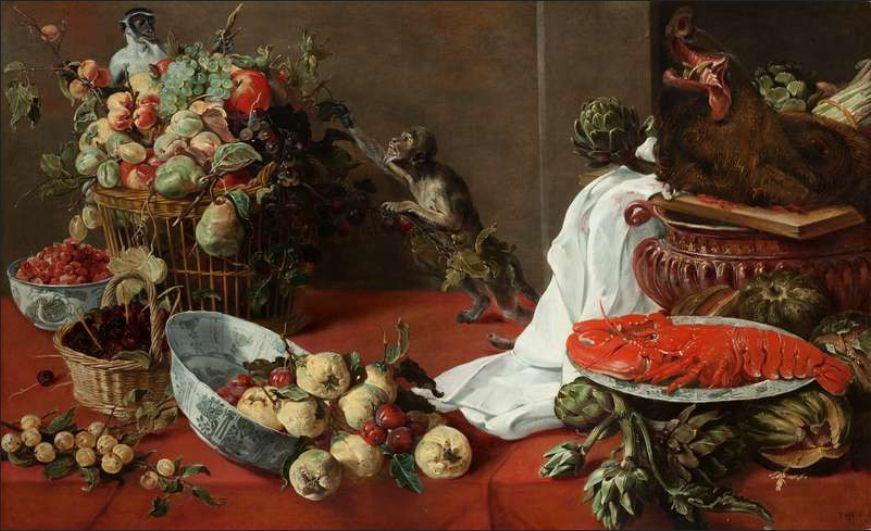Centuries-Old Paintings Help Researchers Track Food Evolution
Art inadvertently documents the domestication of carrots, wheat, watermelon and other culinary delights
:focal(1901x804:1902x805)/https://tf-cmsv2-smithsonianmag-media.s3.amazonaws.com/filer/52/29/522994fe-4def-4ebb-b2f1-51793af24c53/fruitstall.jpg)
In Fruit Stall, a Baroque masterpiece by artist Frans Snyders, an impressive array of produce appears strewn across baskets and platters on a large wooden table. Some of the items on offer are instantly recognizable: Take, for instance, the green grapes overflowing from a large basket at the center of the table. But other goods, including a split-open green fruit dotted with black seeds, are less familiar to the modern eye.
Plant geneticist Ive De Smet and art historian David Vergauwen studied Fruit Stall firsthand during a visit to the State Hermitage Museum in St. Petersburg several years ago. While viewing the work, the pair realized that neither could identify some of the fruits depicted in the scene, De Smet tells CNN’s Kristen Rogers. Initially, the scientist theorized that Snyders, who specialized in still-life paintings featuring fruit, vegetables and animals, lacked talent.
“But [Vergauwen] told me this was actually one of the best painters from the 17th century,” says De Smet in a statement.” So, if that’s how the fruit was depicted, that’s how it should look.”
This discussion inspired the friends to embark on an unconventional research venture newly cataloged in the journal Trends in Plant Science. By combining modern plant genetics with centuries of still-life paintings, the researchers realized that they could create a visual timeline of produce domestication. Now, they hope to crowdsource a library of relevant artworks in order to analyze a wider breadth of sources.
“We started to do some digging and I guess we’ve never stopped digging,” De Smet tells ZME Science’s Tibi Puiu. “Some friends play tennis together or go fishing. Ive and David visit museums, meet other scholars, look at paintings and study the history of our modern foods.”
/https://tf-cmsv2-smithsonianmag-media.s3.amazonaws.com/filer/1a/d6/1ad61f92-b94d-4e58-897e-2ca63ba478ca/2020_july21_artfood.jpg)
Some of the oldest works cited in the study come from ancient Egypt, where artists depicted watermelons with dark and light green stripes similar to those seen today. Genetic analysis of a watermelon leaf found in an Egyptian tomb suggests the modern fruit’s millennia-old predecessor tasted like cucumbers, wrote Vergauwen and De Smet in a 2019 paper.
Artistic portrayals of produce are useful because they can reveal the step-by-step processes through which humans tamed wild plants into something delicious, as well as when certain foods appeared in different parts of the world, according to the study.
“We are mainly interested in the story that, say, the modern orange carrot made from its humble beginnings as a weed, to its current popular form,” De Smet explains to CNN. “Genomes of ancient plant-based foods can help us understand what this plant could have looked like—for example, color based on the active pathways that produce different colors—and which characteristics it might have possessed—for example, sweetness. This helps us pinpoint the appearance of certain characteristics on a timeline, the same way paintings can.”
Art allows researchers to trace the paths traveled by such foods as tomatoes, which were feared to be poisonous during the 16th century but became a staple in 19th-century Italian kitchens. Tomatoes originated in Peru, and the cultivated plant’s wild ancestor can still be found there today, reported Barry Estabrook for Smithsonian magazine in 2015.
/https://tf-cmsv2-smithsonianmag-media.s3.amazonaws.com/filer/79/32/79323be2-9023-4fcc-aa95-71017bb1dc4f/egyptfood.jpg)
In Italy’s Umbria region, agronomist Isabella Dalla Ragione is spearheading similar efforts by using Renaissance paintings to rediscover lost fruits and vegetables. As Vittoria Traverso reported for Atlas Obscura in February, Dalla Gagione searches abandoned fields for plants bearing forgotten fruits. Many were left behind during the shift to industrialization because they grew too slowly or couldn’t be harvested with machinery. Comparatively, the foods studied by De Smet and Vergauwen are often ancestors of modern varieties.
All depictions of food are subject to artistic license, the researchers note in the paper. Snyders’ market scenes, for instance, depict a wider variety of fruit than could possibly be harvested in a single season. And some modern artworks—consider Pablo Picasso’s Bowl of Fruit, Violin and Bottle—are so abstract that they offer few insights on foods’ actual appearance.
“Searching through paintings and other art forms is certainly an avenue of pursuit,” Esther van der Knaap, a plant biologist at the University of Georgia’s College of Agricultural and Environmental Sciences who wasn’t involved in the study, tells CNN. “While imperfect, historical art offers additional insights into the traits that were important centuries ago.”
To gauge how accurately a given painter portrays their subject, De Smet and Vergauwen use roses as a reference point. The flowers have been domesticated for around 5,000 years, and the steps the plant took toward domestication are well-documented.

Using art to track fruits and vegetables’ evolution comes with its own set of challenges. As CNN notes, online catalogs of museums’ collections often “offer only brief titles and descriptions and small photos of certain artworks,” making it difficult to easily identify relevant paintings. Additionally, many potentially crucial artworks are housed in private collections that the researchers are unable to visit in person.
“If an interesting 17th-century tomato is depicted in the kitchen of a Spanish monastery that is almost never open to visitors, we run the risk of never finding out about that,” De Smet tells ZME. “That is why we need help.”
For now, those hoping to contribute to the #ArtGenetics project must email the authors directly. But an app and a public database of submissions are in the works, according to artnet News’ Sarah Cascone.
“This is the beauty of doing this kind of research today,” De Smet says to CNN. “Crowdsourcing tools will allow you to access a lot more data faster than we ever could by just visiting museums.”